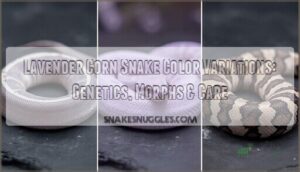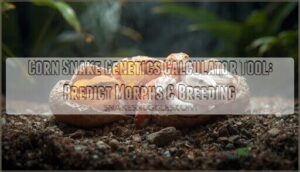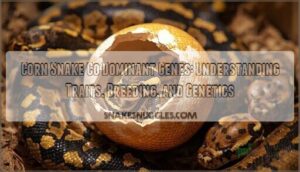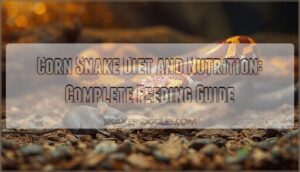This site is supported by our readers. We may earn a commission, at no cost to you, if you purchase through links.
 When breeders first locked eyes with a wild-caught corn snake sporting unusual coloring back in the 1950s, they didn’t just see a pretty reptile—they saw potential. That single observation kicked off decades of selective breeding that transformed corn snakes from relatively uniform wild types into a kaleidoscope of colors and patterns that would make any artist jealous.
When breeders first locked eyes with a wild-caught corn snake sporting unusual coloring back in the 1950s, they didn’t just see a pretty reptile—they saw potential. That single observation kicked off decades of selective breeding that transformed corn snakes from relatively uniform wild types into a kaleidoscope of colors and patterns that would make any artist jealous.
Today’s corn snake morphs showcase what happens when genetics meets dedication, producing everything from snow-white specimens to bold reds and even scaleless wonders. Understanding these morphs means cracking the code on recessive traits, dominant genes, and how pigment mutations work together to create each unique appearance.
Whether you’re eyeing your first corn snake or looking to understand what makes a $5,000 Palmetto different from a $50 Amelanistic, the genetics behind these morphs tell a fascinating story of selective breeding success.
Table Of Contents
- Key Takeaways
- Corn Snake Morph Overview
- Rare Corn Snake Morphs
- Corn Snake Genetics Explained
- Color-Based Morphs Explained
- Corn Snake Morph Prices and Availability
- Frequently Asked Questions (FAQs)
- What are corn snake morphs?
- Why do corn snakes have different color morphs?
- How do you identify a corn snake morph?
- Are corn snake morphs genetic?
- Are corn snakes a good morph?
- What is the corn snake morph Conservation Society (csmcs)?
- Can corn snakes have more than one morph?
- Do corn snake morphs have genetics?
- How are corn snake morphs produced?
- Why are corn snake morphs important?
- Conclusion
Key Takeaways
- Corn snake morphs emerged from decades of selective breeding starting in the 1950s, transforming a single wild-caught snake with unusual coloring into over 800 recognized genetic variations that demonstrate how recessive traits, dominant genes, and pigment mutations combine to create everything from snow-white specimens to scaleless wonders.
- Understanding the genetic mechanics—particularly how recessive traits require two copies from both parents while codominant genes blend parental traits into intermediate expressions—is essential for both appreciating existing morphs and predicting breeding outcomes through tools like Punnett squares.
- Rare morphs command premium prices based on genetic complexity, breeder reputation, and scarcity, with Palmetto morphs reaching $4,000 due to their single wild-caught founder lineage, while scaleless morphs require extra care for shedding and temperature regulation despite their striking velvet-like appearance.
- The value of corn snake morphs extends beyond aesthetics, as they’ve become important tools for genetics research and conservation while demonstrating that the most valuable morphs aren’t always the rarest—they’re the ones where breeders first solved complex genetic puzzles through strategic selective breeding.
Corn Snake Morph Overview
Corn snake morphs have exploded in variety over the past few decades, thanks to dedicated breeders who’ve achieved a remarkable range of colors and patterns. Understanding how these morphs came to be—and what makes each one unique—starts with knowing the basics of breeding history, genetic mutations, and the visual traits that define them.
Let’s break down the foundation of corn snake morphs so you can appreciate what goes into creating these stunning reptiles.
History of Corn Snake Breeding
When hobbyists first started keeping corn snakes in the late 1970s, nobody imagined that a few wild-caught snakes with unusual colors would spark a breeding revolution that’s still going strong today. Early breeding practices shifted from curiosity to methodical science as dedicated breeders tracked color inheritance, experimented with selective breeding, and shared breeder practices within tight-knit communities. These breeding innovations transformed corn snake breeding forever:
Late 1970s breeders transformed casual curiosity into methodical science, documenting wild variants and sharing data that sparked corn snake breeding’s ongoing revolution
- Documenting wild-caught variants with unusual pigmentation patterns
- Testing genetic discoveries through controlled breeding techniques
- Building breeder reputation by sharing morph development data
- Establishing naming standards for newly recognized color variations
This foundation enabled today’s amazing diversity.
Genetic Strains and Mutations
Once those breeding pioneers cracked the code on color inheritance, the real magic started—they discovered that tiny genetic mutations could turn a standard corn snake into something remarkable. Here’s how Corn Snake Genetics works at the fundamental level:
- Recessive traits need two copies from both parents to show up
- Dominant traits express with just one copy
- Pigment mutations alter melanin and erythrin production
- Polygenic traits involve multiple genes working together
- Gene dominance determines which characteristics appear first
Selective breeding combines these genetic strains strategically, while hybrid vigor occasionally produces unexpectedly vigorous offspring. Understanding these mutation types transforms casual keepers into successful breeders.
Color and Pattern Variations
Genetic mutations are just the blueprint—what really catches your eye is how those genes paint themselves across a corn snake’s scales. Pigment gene control determines melanin distribution and erytherin distribution, creating corn snake color variations from blazing reds to soft lavenders.
Pattern variations range from classic blotched saddles to completely patternless designs—scale structure effects can even eliminate borders entirely.
Designer morph creation combines these traits strategically, producing corn snake morphs that showcase nature’s artistic potential through selective breeding. Each snake becomes a living canvas where genetics meets visual artistry.
Rare Corn Snake Morphs
If you’re looking for something truly special, rare corn snake morphs are where the magic happens. These snakes push the boundaries of what’s possible through selective breeding, resulting in jaw-dropping appearances that command attention and premium prices.
Let’s explore three of the most sought-after rare morphs you’ll encounter in the hobby.
Scaleless Morph Characteristics
If you’ve ever wanted to feel what a snake made of velvet might be like, the scaleless corn snake is about as close as you’ll get in real life. This unusual genetic mutation eliminates traditional scales across most of the body, leaving behind wrinkled, leather-like skin with an incredibly smooth texture. The head stays almost completely scaleless except around the nose and lips, while ventral scales remain intact—nature’s clever way of letting these snakes still move properly.
Scaleless genetics follow complex inheritance patterns, making breeding challenges more intense than with typical corn snake morphs. You’ll need to monitor genetic health carefully since these snakes face specific complications. Shedding issues crop up more frequently because of their unique skin texture, and heat regulation becomes trickier without protective scales. That’s why scaleless morph characteristics demand extra attention—higher humidity helps with sheds, and maintaining precise temperatures prevents stress.
Despite the additional care requirements, these corn snakes showcase stunning combinations when breeders work scaleless genetics into morphs like Lavender or Snow, creating living masterpieces that push the boundaries of corn snake genetics.
Avalanche and Blizzard Morph Prices
When you’re ready to step up your corn snake collection, Avalanche and Blizzard morphs represent two stunning white-bodied varieties with distinct price points. The Avalanche morph commonly runs between $200 and $400 on reputable marketplaces, with some baby specimens starting around $175. Meanwhile, Blizzard morph snakes remain more accessible at $70 to $100, occasionally climbing above $100 for specimens carrying additional genetic traits.
Breeder pricing strategies reflect the complexity behind each morph—Avalanches carry triple-recessive genetics (amelanistic, anerythristic, and diffused), while Blizzards showcase double-recessive traits. These snakes are popular pets and average around $50.
Market demand shifts favor these white morphs:
- Avalanche specimens average $300, commanding premium prices for their unique pink-and-white coloration
- Established bloodlines from reputable corn snake breeders push prices toward the upper ranges
- Morph price trends show Avalanches maintaining consistent value due to breeding complexity
- Blizzards offer solid morph investment potential with stable availability and moderate pricing
Understanding factors affecting morph prices—including breeder reputation, lineage quality, and genetic rarity—helps you make informed decisions about corn snake morph prices and availability while considering ethical pricing concerns in the hobby.
Palmetto Morph Rarity and Value
Why do Palmetto morphs command such eye-popping prices in today’s market? Discovered from a single wild South Carolina snake in 2008, this incompletely dominant mutation produces striking leucistic patterns that instantly captivate collectors. Visual identification is straightforward—these snakes display white bodies with scattered pigmented spots and occasional "bug eye" defects that present ongoing breeding challenges. Palmetto Corn Snakes are a type of leucistic morph.
Here’s what drives Palmetto genetics value:
- Market trends show prices ranging $600-$4,000 for quality specimens
- Investment potential remains strong due to controlled breeding programs
- Rarity factors stem from the single wild-caught founder lineage
- Limited availability keeps demand consistently outpacing supply
Reputable breeders carefully select breeding pairs to minimize defects while maintaining these distinctive morphs’ special appearance and genetic integrity.
Corn Snake Genetics Explained
Understanding corn snake genetics doesn’t require a PhD—just a grasp of how traits pass from parents to offspring. Two key concepts shape every morph you see: recessive traits that hide until paired together, and codominant genes that blend to create something new.
Let’s break down how these genetic patterns work in practice.
Recessive Traits and Inheritance
Think of recessive traits as hidden treasures in your corn snake’s DNA—they’re sitting there, invisible to the eye, just waiting for the right partner to reveal them. These recessive genes only show up when both parents pass along the same mutation.
That’s where Punnett squares become your best friend—they map out breeding strategies and help with carrier identification. Trait masking happens when dominant genes hide recessive expression, but smart breeders use genetic inheritance patterns to predict which offspring will display these stunning recessive mutations and which are just carrying the goods.
Codominant Genes and Morph Combinations
Codominant genes work like a genetic remix—both parent traits show up in the offspring at the same time, creating something entirely new instead of one trait dominating the other. Through selective breeding, you’ll see intermediate expressions that blend parental traits into designer morphs with unique traits.
Here’s what makes codominant corn snake morphs special:
- Genetic strains produce predictable patterns, with heterozygous offspring showing blended color combinations
- Scale structure and pigmentation create stunning visual effects when codominant genes interact
- Pairing two codominant morphs intensifies the effect, producing super forms with even more dramatic appearances
Color-Based Morphs Explained
Now that you understand how genetics work behind the scenes, let’s look at the actual colors these genes produce. Color-based morphs showcase stunning variations from stark whites to deep lavenders, each controlled by specific genetic mutations.
We’ll break down the most popular color categories and what makes each one unique.
Anerythristic and Amelanistic Morphs
If you’ve ever wondered why some corn snakes look like they’ve been painted in black and white while others glow with almost neon intensity, you’re looking at the magic of anerythristic and amelanistic genetics at work.
Anerythristic traits eliminate red pigmentation entirely, leaving you with striking grayscale corn snake morphs—think charcoal blacks against crisp whites. Amelanistic types do the opposite, removing black melanin to showcase vibrant reds, oranges, and yellows that practically pop off the scales.
| Characteristic | Anerythristic | Amelanistic |
|---|---|---|
| Color Reduction | No red pigment | No black melanin |
| Visual Differences | Black, gray, white | Red, orange, yellow |
| Eye Color | Dark | Pink or red |
| Inheritance | Recessive traits | Recessive traits |
| Common Example | Anery Type A | Amelanistic (Albino) |
Both follow recessive inheritance patterns—you’ll need two copies of each gene for expression. Breeding challenges arise when tracking these genetic combinations, but the payoff is amazing. Combine them, and you’ll create snow morphs that blend both mutations beautifully.
Red and Orange Morph Variations
The fiery end of the corn snake color spectrum is where you’ll find some of the most jaw-dropping morphs in the hobby, with reds and oranges that range from soft sunset hues to electric crimson intensities. The bloodred morph eliminates ventral patterning completely, giving you solid scarlet specimens that look hand-dipped in paint. Okeetee Intensity morphs crank up natural pigmentation to eleven—thick black borders frame blazing orange saddles that practically glow under light. Candy Cane morphs flip the script with white backgrounds and bold red blotches, while Creamsicle morphs blend peachy orange bodies with stunning contrast.
Here are color variations that’ll make your heart skip:
- Blood Red morphs with deep crimson bellies free of checkering
- Red Factor genetics that intensify existing orange tones into fire-engine reds
- Sunglow combinations removing darker pigments for pure tangerine brilliance
- Miami phase color morphs showcasing soft coral and salmon undertones
Orange tones in these red and orange morph variations come from selective breeding targeting erythrin pigment cells—that’s the science behind the spectacle.
Lavender and Pewter Morph Characteristics
While fiery reds and oranges steal the spotlight, lavender and pewter morphs bring something entirely different to the table—cool, refined tones that look like they’ve been dusted with twilight.
Lavender genetics work through anerythristic pathways, replacing typical reds with purple-gray hues that range from soft lilac to deeper plum shades. These corn snake morphs generally run $150–300, depending on color intensity and pattern expression.
Pewter combinations blend charcoal grays with subtle markings, creating nearly solid backgrounds priced around $200.
Both morphs offer serious breeding potential—cross them with amelanistic lines, and you’ll create opal or plasma variations that command even higher prices in today’s morph market.
Corn Snake Morph Prices and Availability
When you’re ready to add a corn snake to your collection, price tags can feel like a mystery. What you’ll pay depends on genetics, rarity, and where you’re buying.
Let’s break down what influences these costs and where to find quality snakes.
Factors Affecting Morph Prices
What makes one corn snake cost fifty bucks while another drains your wallet for thousands? The answer boils down to a handful of key factors that shift constantly in the reptile world.
Morph pricing depends on these main elements:
- Genetic complexity – Simple single-gene morphs stay affordable, while triple-gene combinations requiring years of selective breeding command premium prices due to limited availability.
- Breeder reputation – Trusted breeders with proven genetics and health guarantees charge 15-30% more, but you’re paying for peace of mind and quality morph care.
- Market trends – When a morph goes viral on social media, market demand skyrockets overnight, temporarily inflating prices.
Visual appeal matters too. Striking patterns and vibrant colors catch eyes and wallets. Rare morphs with superior genetics will always outprice common varieties, making timing important for smart buyers.
Rare Morphs and Their Values
Understanding rare morph pricing reveals fascinating market dynamics driven by genetics and scarcity. Scaleless genetics push values from $150 to $2,000, depending on pattern quality. Palmetto pricing starts around 0 but outstanding specimens hit,500—males usually cost $300-$400, while females command $550+ due to breeding potential. Avalanche and Blizzard morph prices hover between $179-$300, reflecting their complex genetic requirements. Compound morphs like Plasma and Opal regularly exceed $200 as market demand stays strong.
Value trends from 2022-2025 show rare morphs maintaining premium pricing while common varieties stagnate, making these collector pieces smart investments for serious enthusiasts.
Finding Reputable Breeders and Sellers
Now that you know what rare morphs cost, you’ll want to find trustworthy sources. Start by researching breeder reputation through forums and MorphMarket reviews—experienced keepers share honest feedback about seller transparency and ethical breeding practices. Quality breeders demonstrate genetic knowledge, explain inheritance patterns clearly, and offer health guarantees with return policies.
Look for:
- Documented breeder practices with parent snake photos
- Detailed morph verification and lineage information
- Written health guarantees covering genetic defects
- Transparent pricing that reflects actual breeding complexity
Skip sellers who dodge questions about genetics or breeding methods—reputable sources welcome your scrutiny.
Frequently Asked Questions (FAQs)
What are corn snake morphs?
Morphs materialize through selective breeding, producing striking genetic variations in color and pattern. You’ll discover over 800 recognized corn snake morphs combining wild-type genetics with carefully selected mutations—each showcasing unique color morphs and pattern morphs that demonstrate amazing genetic diversity.
Why do corn snakes have different color morphs?
Genetic mutations alter pigment control in corn snakes, changing how melanin and erythrin distribute across their scales.
Selective breeding amplifies these natural color variations, creating hundreds of distinct morphs through careful morph development and combining different genetic strains.
How do you identify a corn snake morph?
Every corn snake morph is unique, yet patterns reveal their identity. You’ll identify corn snake morphs by examining coloration clues, pattern types, scale texture, and eye color—your morph identification keys.
Genetic marker tests and breeder documentation confirm hereditary traits for accurate snake morph appearance classification.
Are corn snake morphs genetic?
Yes, corn snake morphs are entirely genetic. Trait expression comes from gene combinations passed from parent to offspring through selective breeding.
Recessive traits, dominant traits, and genetic mutations control morph heritability, creating the stunning color and pattern diversity you see today.
Are corn snakes a good morph?
Corn snakes aren’t a morph—they’re the species. Morphs are color and pattern variations within corn snakes.
All morphs share excellent beginner friendliness, gentle temperament, straightforward manageability, and manageable enclosure needs, making them ideal pets.
What is the corn snake morph Conservation Society (csmcs)?
Ever wonder who’s keeping the hobby ethical and thriving? The CSMCS Mission focuses on Conservation Efforts, Breeding Ethics, and Morph Standards.
Membership Benefits include genetic guidance for rare morphs, education on corn snake genetics, and community connections with responsible breeders preserving unique mutations.
Can corn snakes have more than one morph?
Absolutely—most of the 800+ corn snake morphs you’ll see are actually combinations of multiple genetic traits. When you stack genes like amelanistic and anerythristic together, you create stunning designer morphs like the Snow.
That’s the beauty of multitrait combinations in breeding projects.
Do corn snake morphs have genetics?
You’ll discover that corn snake morphs exist purely because of genetics. Genetic mutations alter color and pattern genes, and selective breeding lets you combine these traits to create stunning new variations. Gene expression determines which morph inheritance patterns appear in offspring.
How are corn snake morphs produced?
You’ll create stunning morphs through selective breeding—pairing snakes with specific genetic mutations like amelanistic or anerythristic genes.
These recessive traits and dominant traits combine during trait inheritance, producing designer morphs with unique colors and patterns through careful morph development.
Why are corn snake morphs important?
What looks simple on the surface—beautiful patterns and colors—actually drives modern genetics research, conservation impact, and scientific research into inheritance patterns.
Corn snake morphs fuel hobbyist appeal, expand genetic diversity understanding, create economic value through snake breeding, and showcase how genetic mutations produce stunning color variations.
Conclusion
Here’s a theory worth testing: the most valuable corn snake morphs explained aren’t always the rarest—they’re the ones where breeders cracked the genetic puzzle first. Understanding how recessive and codominant traits interact doesn’t just satisfy curiosity; it transforms how you appreciate each morph’s journey from wild-type ancestor to captive-bred marvel.
Whether you’re investing in a budget-friendly Amelanistic or dreaming about a Palmetto, you’re now fluent in the language that created them all.
- https://animaldiversity.org/accounts/Lampropeltis_getula/
- https://www.livescience.com/44008-corn-snakes.html
- https://www.petmd.com/reptile/species/corn-snake
- https://www.zoologytalks.com/structure-and-types-of-chromatophores/
- https://a-z-animals.com/blog/corn-snake-prices-purchase-cost-supplies-food-and-more/












